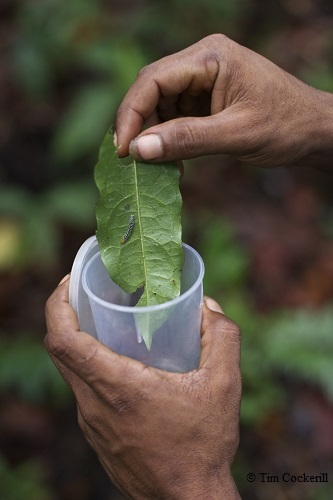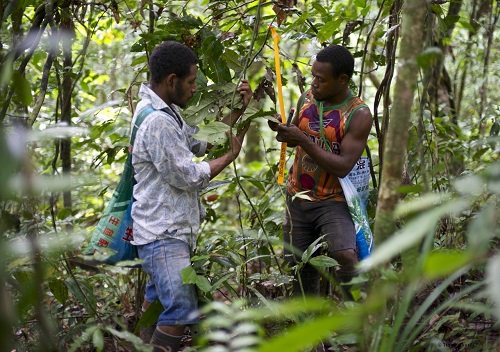From caterpillars to coping strategies…
Thursday, June 30th, 2016. Posted by Becky Morris.
By Becky Morris (co-ed with Emilie Beauchamp)
What do caterpillars and coping strategies have in common? Well, it’s a simple matter of community interaction really… But let me break it down for you! Last week was the UK’s National Insect Week, so I thought it would be appropriate to talk about our most recent exciting, and of course insect-related, project.
Owen Lewis, Sofia Gripenberg and I, from the Community Ecology Research Oxford (CERO) Group, have been collaborating with Vojtech Novotny, from the Czech Academy of Sciences, for nearly 10 years now. Our research focuses on a variety of insects that feed on plants such as caterpillars, leaf miners, gallers and seed predators in Papua New Guinea (PNG), where Vojtech has founded and heads the New Guinea Binatang Research Center. We’ve been studying the interactions between insects and rainforest plants in an amazingly remote and wonderful rainforest in the Madang province (see pictures). I think it’s fair to say that all four of us are fascinated by the multitude of interactions occurring in the rainforest and how they affect biodiversity and functioning of this ecosystem.
Yet these plant-insect communities don’t exist in isolation. They are affected by interactions with other species, including tiny parasitic wasps and predators such as spiders that attack and eat the insects feeding on the plants. They are also increasingly threatened by climate change (rising temperatures) and associated extreme weather events. In fact PNG has been severely affected by the current El Niño event, and the resulting droughts and frost are the worst in at least 20 years.
This is why over the next 18 months, our new project will assess how the changing weather patterns affect the growth and yield of plants, through changes to insect pests and their predators. We chose to focus on plants grown along an elevation gradient, on Mount Wilhelm, since the El Niño will have different effects and present different challenges along the gradient (frost being a major factor at high elevations, and drought at lower elevations). So you see, we are still very much focused on insect-plant interactions. And now come the coping strategies…
Extreme climate events directly impact rainforest ecology, but they also affect the patterns of local resource use by the 85% of the population of PNG who live in forested areas. Subsistence livelihoods in PNG involve each family clearing one or more areas of forest surrounding their village for food production. They plant these so called “food gardens” with mixed crops for two or three years and then shift their cultivation site. Because families rely on food gardens as their only source of food, they are also very vulnerable to environmental changes including El Niño events. So we thought it would be a good idea to widen our ecological attention to these food gardens that have a very immediate impact on the local people. As well as focusing on the crops growing in these gardens and their insect pests, we asked ourselves: how could we promote the resilience to El Niño events of this other type of community – the subsistence farmers of PNG? And to start with, how to study these issues?
Here we were lucky to have EJ Milner-Gulland on our corridor in the Zoology Department…Our initial suggestion of including “some sort of interviews with the villagers” was quickly taken on board by EJ who immediately suggested previously unheard of (to us!) methods, which sounded exactly what we needed. Within about 20 minutes we even had a named postdoc, which is where Emilie Beauchamp came in… She will explore how the impacts of the El Niño affect the people who were farming these gardens and how they coped with the changing conditions, using household surveys to triangulate the presence of pest pressure and to predict behavioural responses to future El Niño events. In addition, she will use “scenario analysis” to understand the constraints and opportunities faced by villagers and to test for possible interventions aiming to increase resilience across (human) communities.
So that’s how we got from caterpillars to coping strategies in a very short space of time, and how a successful collaboration was initiated simply by being on the same corridor. As I said at the beginning, it’s a simple matter of community interaction! I’m looking forward to understanding more about social data collection and analysis, and learning, from EJ and Emilie, how to make sure our project has real impact and influences policy. We’ll also make sure that Emilie knows her leaf miners from her gallers by the time she gets back!
This project is funded by the Natural Environment Research Council (NERC) and the Department for International Development (DFID) through their Understanding the Impacts of the Current El Niño Event research programme.
Follow us on Twitter @CEROxford and @ICCS_updates for updates #PNGelnino



